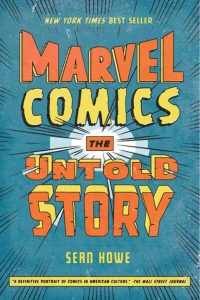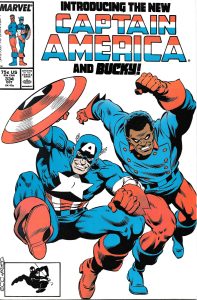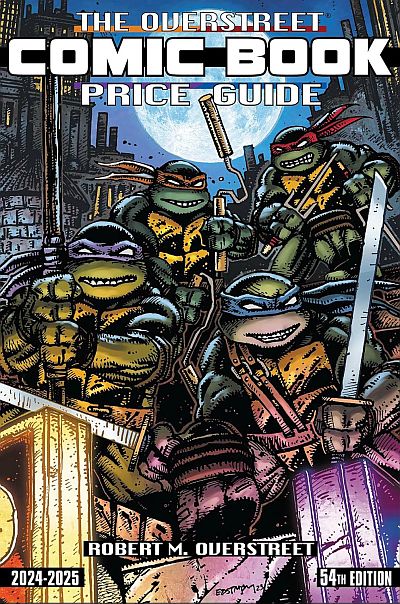
If you’re a fan of comic books, you’ve probably heard of Marvel Comics. This iconic brand has been around for over 80 years and has given us some of the most iconic characters in pop culture. From Spider-Man to Iron Man, the X-Men to the Avengers, Marvel Comics has created a universe that has captured the hearts and minds of millions of fans around the world. But there’s more to the story than just the characters and the stories they tell. In “Marvel Comics: The Untold Story,” author Sean Howe takes us behind the scenes to reveal the fascinating history of this beloved brand.
Howe’s book is a comprehensive look at the people and events that shaped Marvel Comics into the phenomenon it is today. From the early days of Timely Comics to the creation of the Marvel Universe, Howe tells the story of the men and women who brought these characters to life. He also delves into the controversies and struggles that the company faced along the way, including the battle for creative control between Stan Lee and Jack Kirby, and the financial troubles that almost led to Marvel’s demise in the 1990s.
Through interviews with key players and extensive research, Howe paints a vivid picture of the world of Marvel Comics. Whether you’re a die-hard fan or just curious about the history of this iconic brand, “Marvel Comics: The Untold Story” is a must-read. (Amazon link)
The Golden Age of Marvel Comics
Marvel Comics started its journey in the year 1939, during the Golden Age of Comic Books. It was initially known as Timely Comics and was founded by Martin Goodman. Timely Comics was one of the many publishers that emerged during the Golden Age of Comics, which lasted from the late 1930s to the early 1950s.
Creation of Iconic Characters
During the Golden Age, Marvel Comics created some of the most iconic comic book characters of all time. Characters like Captain America, the Human Torch, Namor the Sub-Mariner, and the original Vision were all created during this period. These characters were created by some of the most legendary comic book creators of all time, including Jack Kirby, Joe Simon, and Bill Everett.
Influence of World War II

The Golden Age of Comics was heavily influenced by World War II. Many of the characters created during this period were patriotic in nature and were created to inspire and entertain American soldiers fighting overseas. Captain America, for example, was created as a symbol of American patriotism and was often shown fighting against the Axis powers.
In addition to creating patriotic characters, Marvel Comics also created characters that tackled social issues of the time. For example, the X-Men were created to address issues of prejudice and discrimination. The X-Men were mutants who were persecuted by society for their differences, much like many minority groups during the time.
Overall, the Golden Age of Marvel Comics was a time of great creativity and innovation. Marvel Comics created some of the most iconic comic book characters of all time during this period, many of which are still popular today. The influence of World War II and the social issues of the time also played a significant role in shaping the stories and characters created during this period.
Expansion of the Marvel Universe
Marvel Comics has come a long way since its inception in 1939. Over the years, the Marvel Universe has expanded and evolved in a number of ways. Here are some of the key milestones in the expansion of the Marvel Universe.
Silver Age Milestones
The Silver Age of comics, which began in the late 1950s, was a time of great change and innovation in the comic book industry. Marvel Comics played a major role in this revolution, introducing a number of iconic characters and storylines that are still popular today. Some of the key milestones of the Silver Age include:
- The introduction of the Fantastic Four in 1961, which marked the beginning of Marvel’s modern era.
- The creation of Spider-Man in 1962, which quickly became one of Marvel’s most popular characters.
- The introduction of the X-Men in 1963, which would go on to become one of Marvel’s most successful franchises.
Diversification of Genres
As the Marvel Universe grew and evolved, the company began to experiment with different genres and formats. This led to the creation of a number of groundbreaking titles, including:
- The horror-themed Tomb of Dracula, which debuted in 1972 and ran for 70 issues.
- The martial arts-themed Iron Fist, which debuted in 1974 and helped to popularize the kung-fu craze of the 1970s.
- The science-fiction-themed Guardians of the Galaxy, which debuted in 1969 and has since become one of Marvel’s most popular franchises.
Graphic Novel Innovations
In the 1980s, Marvel Comics began to experiment with a new format known as the graphic novel. These longer, more sophisticated stories allowed writers and artists to explore more complex themes and ideas. Some of the key graphic novels of this era include:
- The Death of Captain Marvel, which explored the themes of mortality and sacrifice.
- The Dark Phoenix Saga, which dealt with issues of power, corruption, and redemption.
- Watchmen, which was not a Marvel comic but still helped to revolutionize the graphic novel format.
Overall, the expansion of the Marvel Universe has been a remarkable journey filled with innovation, creativity, and imagination. Whether you are a longtime fan or a newcomer to the world of Marvel Comics, there is always something new and exciting to discover.
Behind the Panels
Marvel Comics is a company that has been around for decades and has become a household name. Behind the panels of their comics lies a rich history of editorial directions, business decisions, and ownership changes that have shaped the Marvel Universe into what it is today.
Editorial Directions
Marvel Comics has always been known for its unique and diverse characters. From the early days of Spider-Man and the X-Men, to the more recent additions of Ms. Marvel and Miles Morales, Marvel has always pushed the boundaries of what a superhero can be. This editorial direction has allowed them to connect with a wider audience and has made their comics more inclusive.
Another notable editorial direction of Marvel Comics is their focus on continuity. The Marvel Universe is a vast and interconnected world, with characters and storylines that often cross over into each other’s comics. This has allowed for some truly epic storylines, such as the Infinity Saga, that span across multiple titles and characters.
Business and Ownership
Marvel Comics has had its fair share of ownership changes over the years. In the early days, it was owned by Martin Goodman, who later sold it to Perfect Film and Chemical Corporation. The company then went through a series of mergers and acquisitions, eventually ending up under the ownership of The Walt Disney Company.
These ownership changes have had a significant impact on Marvel Comics. For example, the acquisition by Disney has allowed for more resources to be put into the production of Marvel movies and TV shows, which has helped to increase the popularity of the Marvel Universe even further.
In addition to ownership changes, Marvel Comics has also gone through various business decisions that have affected the company. For example, in the 1990s, Marvel went through a period of rapid expansion and oversaturation of the market, which ultimately led to bankruptcy. However, the company was able to bounce back and is now stronger than ever.
Overall, the history of Marvel Comics is a fascinating one that has shaped the comic book industry and popular culture as a whole. Behind the panels lies a rich tapestry of editorial directions, business decisions, and ownership changes that have made Marvel Comics the powerhouse it is today.
Cultural Impact and Legacy
Crossover into Mainstream Media
Marvel Comics’ impact on popular culture is undeniable. From the 1960s to the present day, Marvel has been a major force in the comic book industry. In recent years, Marvel has also crossed over into mainstream media, with blockbuster films, hit television shows, and popular video games. The Marvel Cinematic Universe (MCU) has become a cultural phenomenon, grossing billions of dollars at the box office and captivating audiences worldwide. Marvel has also expanded into television with critically acclaimed shows like “Daredevil” and “Jessica Jones” on Netflix.
Influence on Popular Culture
Marvel Comics has had a significant impact on popular culture. The company’s characters and stories have inspired countless artists, writers, and filmmakers. The X-Men, for example, have been used as a metaphor for various social issues, including civil rights and the AIDS epidemic. Spider-Man, with his relatable struggles and everyday problems, has become one of the most beloved and iconic superheroes of all time. Marvel’s influence can be seen in everything from fashion to music to politics.
Fan Community and Criticism
Marvel Comics has a passionate fan community that spans the globe. Fans of all ages and backgrounds have been drawn to Marvel’s characters and stories for decades. The company has also faced criticism over the years, particularly in regards to its treatment of female characters and people of color. However, Marvel has taken steps to address these issues in recent years, with more diverse representation in its comics and films.
Overall, Marvel Comics’ impact on popular culture and its legacy are undeniable. From its humble beginnings in the 1960s to its current position as a global entertainment powerhouse, Marvel has captivated audiences with its characters, stories, and themes. Whether you’re a lifelong fan or a newcomer to the Marvel Universe, there’s no denying the impact that Marvel Comics has had on the world.
Popular Articles for You!
- The History of Marvel Characters: Origins, Story Arcs & Popularity
- History of Avengers #1-100 (1963-1972) – Assemble of Earth’s Mightiest Heroes
- Batgirl: Breaking Stereotypes in Gotham
- The Most Valuable Comic Books of All Time
- DC Comics Icons: A Decade and a Half of Legendary Characters
- The Role of Kickstarter in Supporting Indie Comic Book Projects
- The Spirit (1940-1952) – Created by Will Eisner
Frequently Asked Questions
Who created the Marvel Universe and what was their first publication?
The Marvel Universe was created by a team of comic book writers and artists, including Stan Lee, Jack Kirby, and Steve Ditko. Their first publication was “The Fantastic Four” in 1961, which introduced the world to a new kind of superhero team. This was followed by other iconic characters like Spider-Man, the X-Men, and the Avengers.
How has the Marvel Universe evolved since its inception?
The Marvel Universe has evolved significantly since its inception, with new characters, storylines, and themes being introduced over the years. The Marvel Universe has tackled issues such as civil rights, drug addiction, and terrorism, and has explored complex themes like identity, family, and responsibility.
What are the key differences between Marvel’s Earth-616 and Earth-19999?
Marvel’s Earth-616 is the primary universe in which most Marvel Comics take place. Earth-19999, also known as the Marvel Cinematic Universe, is a separate universe that exists in the Marvel multiverse. The key differences between the two universes include different character lineups, different storylines, and different interpretations of classic Marvel characters.
Who are some of the most iconic characters introduced in the Marvel Universe?
Some of the most iconic characters introduced in the Marvel Universe include Spider-Man, the X-Men, the Avengers, the Fantastic Four, and the Hulk. These characters have become household names and have had a significant impact on popular culture.
What impact did Stan Lee have on the development of the Marvel Universe?
Stan Lee was instrumental in the development of the Marvel Universe, co-creating many of its most iconic characters and storylines. Lee was known for his innovative approach to storytelling, which included complex characters, realistic dialogue, and socially relevant themes. More on Stan Lee
What are the most significant story arcs in Marvel Comics history?
There have been many significant story arcs in Marvel Comics history, but a few stand out as particularly memorable. These include “The Infinity Gauntlet,” “Civil War,” “Secret Wars,” and “The Dark Phoenix Saga.” These story arcs have had a lasting impact on the Marvel Universe and continue to influence the comics and movies today.
I do hope you have enjoyed this article. If you have enjoyed it or hated it, please leave a comment below. Thanks, MikeyD







